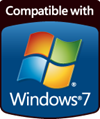A few weeks ago, my good friend Yaron Hezroni, Program Manager on the PC Ecosystem Team here at Microsoft, sent me an email asking me to swing by his office and that he had something really cool for me to check out. I asked if it was something I could blog about and he said yes and suggested I bring my video camera. So I did. What he had to show me was 3M’s new M2256PW 22” Multi-touch Display. The M2256PW is a multi-touch monitor that is designed to recognize 60 touch points (fingers). Windows 7 will report 30 touch points however. It incorporates 3M Projected Capacitive Technology for fast 6 millisecond touch response, supports 1680×1050 screen resolution, and has a special horizontal/vertical viewing angle that allows for off-axis viewing. Oh and it also carries the Compatible with Windows 7 logo.
While 3M markets the M2256PW to support 20 touch points – Windows 7 will actually see 30 touch points. Yaron gave me a demo of the display, where you can see many of its slick capabilities.
I also got to send along some questions to 3M Touch Systems’ Chris Tsourides, business manager and expert on 3M’s multitouch devices, for this blog post. The small Q&A session is below.
Brandon: So first off, tell us about 3M’s collaboration with Microsoft to support Windows 7 and Windows Touch with the M2256PW?
Chris: The M2256PW was designed to interface directly with Windows 7 without the need for additional drivers. The display and touchscreen can be plugged directly into a Windows 7 machine and begin functioning as a multi-touch device. The M2256PW reports into the Window 7 OS as a digitizer as required by the Windows 7 AQ (additional qualification) requirements. Unlike many traditional multi-touch screens, which are tested to support two touches, this screen has been tested during the AQ process for 30 simultaneous touches and is capable of supporting even more.
In dialogue with Microsoft and customers, we realized that latency is one of the key attributes that contributes to a poor user experience, so 3M designed the touch system with a very high sample rate >120 hz, resulting in touch response time below 6 ms. This creates the opportunity for software developers to virtually eliminate any user-perceivable latency.
Brandon: Talk to us a little about the design of the M2256PW? This particular display allows for use in different angles not usually seen with displays.
Chris: Multi-touch is changing the way users interface with touchscreens. Multi-touch applications have wider ranges of use than traditional non-touch or single-touch displays. Traditional displays are typically viewed at 80-90 degree angles, single-touch displays are typically viewed/used 60-90 degree range and multi-touch displays are more commonly used in the 0-60 degree angles. This allows customers to utilize products in new applications such as table tops or tiled applications.
Brandon: Where do you see the M2256PW being used? (What field/industry/user-type etc.)
Chris: The primary markets are professional, “pro-sumer” and commercial. The primary professional markets include CAD, Pro Audio visual, media and broadcast, military, financial and healthcare. Pro-sumer markets include home gaming, home automation, and educational games. In the more traditional commercial markets, such as retail and hospitality, we have seen these devices make their way into product selection kiosks (specifically in high-end electronics), POI (wayfinders) and digital signage.
Brandon: Can you tell us about any particular customer using this display today in combination with Windows 7 to do some interesting things?
Chris: The majority of our customers are utilizing Window 7 for its simple plug-and-play functionality with our display. We have a number of customers who are able to implement multi-touch and multiple monitors to create really outstanding user experiences. One is being done in a simulation and training environment where the customer is using 8-10 monitors together to create a sensory and visual experience that leverages our multi-touch display. We also have a recent implementation where a customer is using interactive multi-touch over IP using two networked, multi-touch screens displays in different locations to create a single collaborative environment.
Special thanks to 3M for the Q&A and helping with the post!

